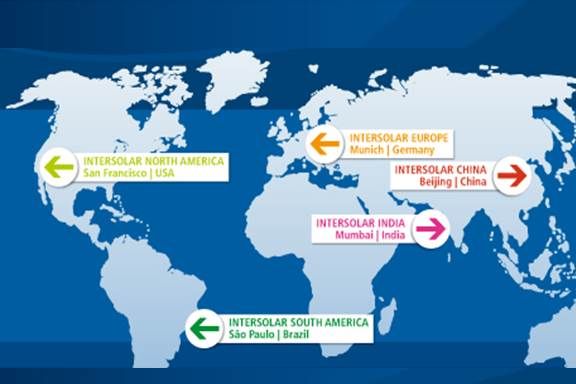Few people have a better view of the solar industry or have been more astute at predicting where it would go than Intersolar founder and CEO Markus Elsaesser. He talked to GTM about his perspective and solar's future last week at Intersolar North America 2013 in San Francisco.
Elsaesser first brought his successful international event to San Francisco in 2008, just as the U.S. solar industry was starting to take off. Then he took Intersolar to India when that country only had 20 megawatts of grid-connected solar, but had just instituted a target of 20,000 megawatts by 2022.
Two years later, he founded Intersolar China just before solar’s unprecedented expansion there. And this year, Intersolar opened in Sao Paulo, Brazil, just as the international industry has begun looking to Latin America.
The only time his timing was off was at the beginning. He founded the first Intersolar in 1991, when he was still a college student. “There was almost no industry or market, just the vision that renewables would someday play a role in the energy supply,” Elsaesser said. German lawmaker and solar advocate “Hermann Scheer was a speaker at the first conference and really inspired me. He was a visionary. The feed-in tariff he helped design and put in place created the international market.”
But that market didn’t take off until 2001, when, thanks to its feed-in tariff, Germany took over the global market. “There was so much demand for exhibitor space we had to move to Munich in 2008. About the same time, we decided to start the U.S. show in San Francisco.”
The decision to create a new Intersolar is based on the local market and local policies, Elsaesser explained. But he often sees indications that those things will happen before anybody else seems to perceive them.
Just before India introduced its 20,000-megawatt target, Elsaesser said, India’s energy minister came to Intersolar in Munich. “He was more interested in wind and biomass than in solar at the time and was only scheduled to stay for two hours. He stayed for three days. India is now a gigawatt-scale market.”
In 2010, Elsaesser met with Saudi Arabia’s electricity and commerce ministers in Riyadh. Then, he said, “they sent a representative to our show in Munich. After that, Saudi Arabia set a goal to implement 48 gigawatts of solar.”
Like India in 2009, Brazil now has only 20 megawatts of installed grid-connected capacity. “But we had our conference in August, and they introduced net metering and had it in place by the end of the year,” Elsaesser said. There were 200 attendees at the one-day conference and no exhibits.
“We introduced the feed-in tariff and addressed things like tax issues and regulatory barriers and introduced the idea of an industry association. At the next Intersolar Brazil, we will have exhibitors.”

Elsaesser is optimistic about the future of solar and offered a few predictions from his perspective.
Module manufacturer bankruptcies: “The balancing of supply and demand is what happens in other new businesses. We are talking mainly about the failure of manufacturers. In the future, there will also be a lot of distributors, developers, and downstream companies. In 2011, we had 530 solar manufacturers from China at Intersolar. This consolidation phase was not a surprise. We are in the middle of it. Still, the balance of systems segment and the energy storage segment and other segments are growing.”
Utility-scale solar: “I don’t think utility-scale solar is dead at all. There might not be as much development in the U.S. but I see a lot coming in China. I just had a meeting with ministers from India, and they said they will bring a 200-megawatt PV plant on-line in October. A significant part of Saudi Arabia’s 48 gigawatts will also be utility-scale. I think there are a lot of places where there will be utility-scale solar.”
Module quality issues: “There are issues about the quality of PV modules, and the industry is doing its homework to get a handle on it. Labs like Fraunhofer and TUV Rheinland are working on it, and I hope they will find solutions. An associated issue is that in some places where there are module quality issues, the companies that made them don’t exist anymore and there is no recourse for people who have failing panels. But, again, the industry associations are working to solve the problem.”
The balance-of-system market segment: “In the past two or three years, everything was focused on bringing module costs down. Now, there is a shift to bringing costs down in the balance-of-systems area because module prices are so low. The whole balance-of-system segment is growing. Balance-of-system exhibitors booked 25 percent more floor space at Intersolar North America this year. And there is a lot of interest already for next year from companies that did not participate this year. New manufacturers are putting pressure on the traditional market leaders. I hope the technologies from the new companies are as reliable as those from the traditional market leaders. We will see.”
Solar’s future: “I don’t believe the publicity that says the boom is over. For sure, we have overcapacity and shrinking margins and a lot of cost pressure. This will last for a year or two more. But I think we are just at the beginning. Solar is becoming more and more affordable. It is cheaper in a lot of markets than traditional energies. We will go from this year’s 30 gigawatts of new installations to over 100 gigawatts of new installations per year.”



